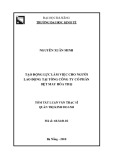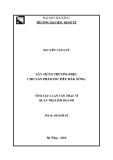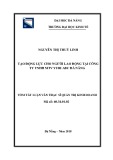
ON DIFFERENCE EQUATION WITH
GENERALIZED DILATION
PAVEL PLASCHINSKY
Received 22 July 2004; Revised 24 January 2005; Accepted 27 January 2005
We investigate the functional equation with generalized dilation in the special weighted
functional spaces. We provide some sufficient conditions for the existence of the inversion
operator in the same form and consider several examples.
Copyright © 2006 Pavel Plaschinsky. This is an open access article distributed under the
Creative Commons Attribution License, which permits unrestricted use, distribution,
and reproduction in any medium, provided the original work is properly cited.
1. Introduction
Consider the functional equation with generalized dilation:
∞
n=1
a(n,x)nντfnτx=g(x), x∈(0;∞), τ,ν∈R, (1.1)
where a(n,x) is bounded almost everywhere on (0;∞) for arbitrary natural n, and the
sequence (an) of their L∞-norms belongs to l1.
The equations of this type are used in many areas of physics [4,5], for example, irradi-
ation of black bodies. But in physics there were no rigorous proofs, rather it was the idea
of using the method of the Dirichlet convolution inverse (we will call it here the discrete
Mellin convolution).
One can find the expansive bibliography and history of the algebraic approach to the
integral and difference equations with transformed argument in, for example, [1–3,8].
The traditional use of the integral transforms in the case of constant coefficients does
not work in LpBanach spaces, and we apply the method of the reciprocal sequences.
In [6], the functional operator Ma,τon the left-hand side of (1.1) was completely inves-
tigated in the case of constant coefficients a(n). In [7], it was shown that the operator Ma,τ
is bounded in Lν,p, that is, in the Banach space of functions f(x)suchthat f(x)xν−1/p ∈Lp
with the corresponding norm. In addition, sufficient conditions for the existence of the
inversion operator of the same form as in (1.1) were found:
(1) a(n,x)=(a1∗a2∗···∗am)τ(n,x);
(2) ak1<essinf |ak(1,x)|+esssup|ak(1,x)|,k=1,...,m.
Hindawi Publishing Corporation
Advances in Difference Equations
Volume 2006, Article ID 27512, Pages 1–8
DOI 10.1155/ADE/2006/27512

2Ondifference equation with dilation
In terms of the discrete Mellin convolution with τ-degree dilation (DMCτ),
(a∗b)τ(n,x)=
km=n
a(k,x)bm,kτx, (1.2)
these conditions imply the existence of the reciprocal sequence (a−1(n,x)) in l1.There-
ciprocal sequence (a−1(n,x)) is defined almost everywhere on (0;∞) by equality
a∗a−1τ(n,x)=a−1∗aτ(n,x)=e1(n)=⎧
⎨
⎩
1, n=1,
0, n>1.(1.3)
Under these conditions, the solution of (1.1) for arbitrary function g(x)fromLν,pis of
the form
f(x)=∞
n=1
a−1(n,x)nντgnτx,x∈(0;∞), (1.4)
since the inversion operator M−1
a,τis Ma−1,τ.
Furthermore, this form of solution is useful in calculations because of using concrete
local values of functions, unlike using all values in integral transforms.
The goal of this paper is to find wider sufficient conditions in the case of arbitrary
coefficients a(n,x).
2. Main theorem
We denote
ainf =essinf
(0;∞)
a(1,x)
,a1=esssup
(0;∞)
a(1,x)
,
an(δ)=esssup
(0;δ)
a(n,x)
a(1,x)
,an(Δ)=esssup
(Δ;∞)
a(n,x)
a(1,x)
,
an(0) =lim
δ→0an(δ), an(∞)=lim
Δ→∞an(Δ),
an=esssup
(0;∞)
a(n,x)
a(1,x)
,n=2,3,....
(2.1)
Theorem 2.1. If ainf >0and
∞
n=2
an(0) <1, ∞
n=2
an(∞)<1, (2.2)
then there exists the reciprocal sequence (a−1(n,x)) with respect to the DMCτin l1.
Corollary 2.2. Under the conditions of the theorem, (1.1)hasauniquesolutionanditcan
be expressed in the form (1.4).
Proof of the theorem. The condition ainf >0 is the necessary inversion condition for the
sequence a(n,x)[7]. Any sequence (a(n,x)) ∈l1with this property can be introduced as

Pavel Plaschinsky 3
the DMCτof the sequences (b(n,x)) and (c(n,x)) belonging to l1:
a(n,x)=(b∗c)τ(n,x), (2.3)
where
b(n,x)=⎧
⎨
⎩
a(1,x), n=1,
0, n≥2, c(n,x)=⎧
⎪
⎪
⎨
⎪
⎪
⎩
1, n=1,
a(n,x)
a(1,x),n≥2.(2.4)
The sequence (b(n,x)) is invertible in l1and
b(n,x)=⎧
⎪
⎨
⎪
⎩
1
a(1,x),n=1,
0, n≥2.
(2.5)
If the sequence (c(n,x)) is also invertible in l1, then the sequence (a(n,x)) is invertible
and [7]
a−1(n,x)=c−1∗b−1τ(n,x).(2.6)
The proof of the existence of (c−1(n,x)) in l1will be divided into several parts.
(1) There are two positive numbers δand Δsuch that
∞
n=2
an(δ)<1, ∞
n=2
an(Δ)<1.(2.7)
Indeed, as (c(n,x)) ∈l1, for arbitrary ε>0 there is a natural Nsuch that
∞
n=N+1
esssup
(0;∞)
a(n,x)
a(1,x)
<ε. (2.8)
Moreover, for any n=2, ...,N, there are two positive numbers δnand Δnsuch that
esssup
(0;δn)
a(n,x)
a(1,x)
≤an(0) + ε
N,esssup
(Δn;∞)
a(n,x)
a(1,x)
≤an(∞)+ ε
N.(2.9)
Denoting the min{δn}by δand the max{Δn}by Δ, we obtain the inequalities
∞
n=2
an(δ)<
N
n=2
an(0) + 2ε< ∞
n=2
an(0) + 2ε<1,
∞
n=2
an(Δ)<
N
n=2
an(∞)+2ε< ∞
n=2
an(∞)+2ε<1,
(2.10)
since εmay be taken arbitrarily small.

4Ondifference equation with dilation
(2) There is an explicit inversion formula [7]:
c−1(n,x)=
β∈An
(−1)|β|
i(β)
|β|
k=1
cik,iτ
1iτ
2···iτ
k−1x, (2.11)
where
An=β=β2,β3,...,βn,βm=0,1,2,...
n
m=2
mβm=n,n≥2, (2.12)
i(β)=the set of permutations of the natural numbers corresponding to βm= 0(thenum-
ber mis taken βmtimes),
|β|=
n
m=2
βm.(2.13)
Thus we need to show that the sum
c−1
≤∞
n=1
β∈An
i(β)
|β|
k=1
esssup
(0;∞)
aik,iτ
1iτ
2···iτ
k−1x
a1, iτ
1iτ
2···iτ
k−1x
(2.14)
is finite. Without loss of generality, we may assume that τ>0.
(3) On the interval (Δ;∞), we obtain as in [7]
∞
n=1
esssup
(Δ;∞)
c−1(n,x)
≤∞
n=1
β∈An
|β|!
β!aβ(Δ)=∞
s=0
|β|=s
s!
β!aβ(Δ)
=∞
s=0∞
n=2
an(Δ)s
=1−∞
n=2
an(Δ)−1
<∞.
(2.15)
Here
β!=
n
m=2
βm!, aβ(Δ)=
n
m=2
aβm
m(Δ), (2.16)
and the final equality is obtained as the sum of decreasing infinite geometric progression
in view of (2.7).
(4) We investigate the sum (2.14) on the interval (δ;Δ).
Without the loss of generality, we may assume that Δ=δ2Lτ ,whereL∈N.Inevery
product from (2.14), we will take the factors with condition i1···ik−1≤2L.Atleastone
such factor is taken, because the first one depends only on x.
We say that a shift is a boundary shift with respect to the 2Lif i1···ik−1≤2L,but
i1···ik−12>2L. We say that a shift is an inner shift if i1···ik−12≤2L.

Pavel Plaschinsky 5
We first estimate the sum from (2.14) with inner shifts in the product. The number of
multiples is at most L, and similarly to the previous case, we obtain the number
⎛
⎝1−∞
n=2
anL+1⎞
⎠×1−∞
n=2
an−1
(2.17)
as an upper bound of the sum.
We group the rest of the sum (2.14) according to the common beginning of the prod-
ucts, bounded by the factor with a boundary shift. Taking the common beginning out of
each group, we thus obtain the same sum within the boundary shift (i1···ik)τ.
Indeed, the sum (2.14) consists of various finite products of the norms of the elements
c(n,x) with special type shifts. If we take out a part of the sum with the same beginning,
then it also consists of various finite remainders of products within the considered shift,
which is the same sum as in (2.14).
In view of (i1···ik)τδ≥2Lτ δ=Δ, this sum can be bounded by the number
1−∞
n=2
an(Δ)−1
.(2.18)
As the sum of the common beginnings consists of at most L+ 1 multiples in a sum-
mand, the upper bound is
⎛
⎝1−∞
n=2
anL+2⎞
⎠×1−∞
n=2
an−1
.(2.19)
Combining all the results thus obtained on the interval (δ;Δ), we have
∞
n=1
esssup
(δ;Δ)
c−1(n,x)
≤1−∞
n=2
an−1
×⎡
⎣1−∞
n=2
anL+1
+⎛
⎝1−∞
n=2
anL+2⎞
⎠1−∞
n=2
an(Δ)−1⎤
⎦<∞.
(2.20)
(5) We finally investigate the norm on each interval (2−(K+1)τδ;2−Kτδ), where Kis a
nonnegative integer.
As for the previous interval, we first consider the sum with inner shifts with respect to
2K. By analogy, the number
⎛
⎝1−∞
n=2
an(δ)K+1⎞
⎠×1−∞
n=2
an(δ)−1
(2.21)
is an upper bound of the sum.
The rest of the sum (2.14), for the same reason, is bounded by the number
1−∞
n=2an(δ)K+2
1−∞
n=2an(δ)·1−∞
n=2anL+2
1−∞
n=2an·1
1−∞
n=2an(Δ).(2.22)










![Hình ảnh học bệnh não mạch máu nhỏ: Báo cáo [Năm]](https://cdn.tailieu.vn/images/document/thumbnail/2024/20240705/sanhobien01/135x160/1985290001.jpg)















